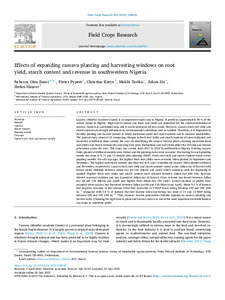| dc.contributor.author | Enesi, R. |
| dc.contributor.author | Pypers, P. |
| dc.contributor.author | Kreye, C. |
| dc.contributor.author | Tariku, M. |
| dc.contributor.author | Six, J. |
| dc.contributor.author | Hauser, S. |
| dc.date.accessioned | 2022-11-24T10:04:16Z |
| dc.date.available | 2022-11-24T10:04:16Z |
| dc.date.issued | 2022-10-01 |
| dc.identifier.citation | Enesi, R., Pypers, P., Kreye, C., Tariku, M., Six, J. & Hauser, S. (2022). Effects of expanding cassava planting and harvesting windows on root yield, starch content and revenue in southwestern Nigeria. Field Crops Research, 286: 108639, 1-10. |
| dc.identifier.issn | 0378-4290 |
| dc.identifier.uri | https://hdl.handle.net/20.500.12478/7927 |
| dc.description.abstract | Cassava (Manihot esculenta Crantz) is an important staple crop in Nigeria. It provides approximately 80 % of the caloric intake in Nigeria. High starch content and fresh root yields are important for the commercialization of cassava. Cassava is a perennial crop, and it can be produced all year round. However, cassava fresh root yield and starch content are strongly influenced by environmental conditions such as rainfall. Therefore, it is important to identify planting and harvest periods to attain maximum yields and starch content and to increase profitability. The present study aimed at (i) comparing changes in fresh root yields and starch contents of cassava planted and harvested at different times around the year (ii) identifying the cassava harvest phase attaining maximum fresh root yields and starch content (iii) assessing how price fluctuations and root yields affect the revenue and income generation across the year. This study was carried from 2017 to 2019 in southwestern Nigeria. Existing cassava fields planted at different months were visited and the planting dates were recorded. Harvesting for each planting month was done at 9, 11 and 13 months after planting (MAP). Fresh root yield and starch content varied across planting months. For all crop ages, the highest fresh root yields were recorded when planted in September and December. The highest root starch content was observed in 9- and 13-months old cassava when planted in March and November, respectively. Cassava fresh root yield and starch content varied across Julian day of harvest with lowest yields obtained between Julian day 60–120 (March and April) which coincides with the beginning of rainfall. Highest fresh root yields and starch content were attained between Julian day 180–330. Revenue showed seasonal variation and was dependent Julian day of harvest. Gross revenue was lowest between Julian day 60 and 120 (March and April) and highest from Julian day 180 (July). Lowest incomes or profits were recorded when cassava was harvested between Julian day 60 and 120 (March and April). About 9.1 % of farmers had negative revenues or lost income when they harvested at 9 MAP hence losing between 150 and 200 USD ha−1 compared with 2.8 % of farmers that lost income when harvesting was done at 11 and 13 MAP losing between 100 and 150 USD ha−1. Thus, farmers’ income generation critically depends on cassava planting and harvest dates. Choosing the right time to plant and harvest cassava is one of the most important decisions farmers can make to maximize profit. |
| dc.description.sponsorship | Bill & Melinda Gates Foundation |
| dc.format.extent | 1-10 |
| dc.language.iso | en |
| dc.subject | Rain |
| dc.subject | Cassava |
| dc.subject | Starch |
| dc.subject | Planting Date |
| dc.subject | Crops |
| dc.subject | Roots |
| dc.subject | Yields |
| dc.subject | Nigeria |
| dc.title | Effects of expanding cassava planting and harvesting windows on root yield, starch content and revenue in southwestern Nigeria |
| dc.type | Journal Article |
| cg.contributor.crp | Roots, Tubers and Bananas |
| cg.contributor.affiliation | Swiss Federal Institute of Technology |
| cg.contributor.affiliation | International Institute of Tropical Agriculture |
| cg.coverage.region | Africa |
| cg.coverage.region | West Africa |
| cg.coverage.country | Nigeria |
| cg.coverage.hub | Headquarters and Western Africa Hub |
| cg.researchtheme | Natural Resource Management |
| cg.identifier.bibtexciteid | ENESI:2022a |
| cg.isijournal | ISI Journal |
| cg.authorship.types | CGIAR and advanced research institute |
| cg.iitasubject | Agronomy |
| cg.iitasubject | Cassava |
| cg.iitasubject | Farming Systems |
| cg.iitasubject | Food Security |
| cg.iitasubject | Plant Breeding |
| cg.iitasubject | Plant Production |
| cg.journal | Field Crops Research |
| cg.notes | Open Access Article; Published online: 28 Jul 2022 |
| cg.accessibilitystatus | Open Access |
| cg.reviewstatus | Peer Review |
| cg.usagerightslicense | Creative Commons Attribution 4.0 (CC BY 0.0) |
| cg.targetaudience | Scientists |
| cg.identifier.doi | https://dx.doi.org/10.1016/j.fcr.2022.108639 |
| cg.iitaauthor.identifier | Pieter Pypers: 0000-0001-8913-0589 |
| cg.iitaauthor.identifier | Christine Kreye: 0000-0001-6090-2856 |
| cg.iitaauthor.identifier | Stefan Hauser: 0000-0002-6329-7783 |
| cg.futureupdate.required | No |
| cg.identifier.issue | 108639 |
| cg.identifier.volume | 286 |

